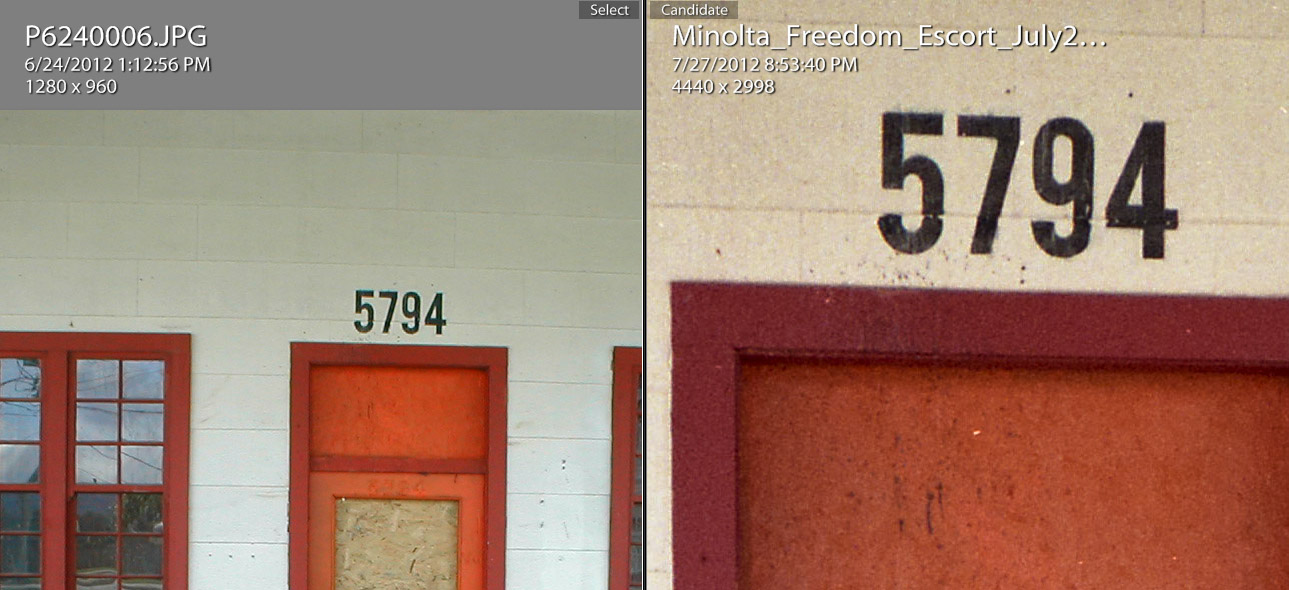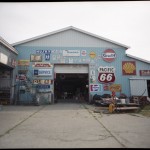Sep
29
2012

With this sketch it’s apparent how I have used a photograph as the source. While every stroke is unique and not directly derived from the photograph I had the source image as an underlying layer while painting. This image could have been improved if I had painted some more dark greens at the base of the half barrel. As it is the barrel is not grounded and appears to float on the image plane losing the three dimensional effect, appearing flat and giving away it’s photographic origins.
Not only can you use the iPad to sketch but you can use it to capture your source material too with it’s built in camera or through the camera connection kit. All of this was done far away from any Internet connection or source of AC power. I charged the iPad off of a 12V inverter whenever I needed to.
no comments | tags: iPad, Painting | posted in Drawings, Painting
Sep
27
2012
It’s pretty much universally accepted that digital photography today provides a better outcome than film as well as a better user experience. Now with more than a decade of digital being mainstream I’m having a look back to see just when that barrier was crossed for the average user. For this comparison (there may be more) I selected two cameras that were available in 2001. The Olympus D-370 is a 1.3Mpixel (1280×960) camera with a 4.5mm F4 lens with 5 elements that gives a 35mm equivalent field of view. And weighing in for film is the Minolta Freedom Escort with it’s 34mm F3.5 four element lens and it’s filmyness. To be fair the Minolta is about ten years older than the Olympus but the film is new.

Seeing as most people get prints that are 4×6 I thought I would see if at this size snapshots from the two cameras would be comparable. At that size the (1280×960) of the Olympus should give nearly 220 pixels per inch. I scanned the negatives at higher resolutions but downsized to a comparable 240 PPI for printing. Both cameras actually produced decent 4×6 prints but the film camera took the edge with it’s better lens and films superior dynamic range.
The Olympus prints were only sharp in the center and the sensor couldn’t record much detail in the dark areas of high contrast images. The Minolta with Fuji Superia film was able to record much of the range of any of the scenes and a lot more detail.
So what exactly does this prove? Well for one thing the output quality of pretty much every camera for the last 10 years has been adequate for making 4×6 prints and web sized images. It wasn’t all flowers and butterflies though if anyone cares to remember the difficulties with getting your images off of a camera and into the computer around that time. The other thing it proves is that this was not the time where digital exceded film for the average user not using an SLR or DSLR.
Here are two comparisons the last one zoomed in to one to one, leaving no doubt about films 2001 superiority.


From here I will pick a different camera combination with higher megapixels and see if I can find that cross over point.
5 comments | tags: camera, Digital, film | posted in Cameras, Photography, Processing
Sep
24
2012
One more post of images from The Museum of Anthropology as well as a few other images from that roll. These were shot with my Baby Bessa which is one of my favorite camera’s Voigtlander Baby Bessa Voigtlander Baby Bessa Sample images Voigtlander Baby Bessa June 2011 Baby Bessa
no comments | posted in Photography
Sep
21
2012
Don’t you just love to hate oxymorons?

The Vivitar Ultra Wide and Slim is one of the ultimate plastic cameras. It has a “Ultra wide” 22mm lens and is an incredibly small camera, you could ever say it’s massively slender. One thing to keep in mind is that it has a fixed aperture of F11 and a fixed shutter speed of 1/125sec. So to get the best results you want to shoot in circumstances that require exposures around that level. I was using ISO 400 film so that would be about EV12 or average daylight. Looking at the roll of film as a whole it’s clear that I pointed the camera towards the light a lot. Well it’s a plastic lens of course it’s going to flare so let it flare. And vignette don’t get my started with the vignetting it’s perfectly awful! OK so it’s bad in a good way and I’m nearly out of oxymorons.
1 comment | tags: camera, film, Photography, wide | posted in Cameras, Photography
Sep
19
2012
Actually it’s more like a black hole sun on my Fuji instant print. I’ve never seen this before but I believe it’s solarization. A quick look through my 1978 edition of The Manual of Photography explains that at a certain point of the exposure curve of a negative the density actually starts to decrease. It also suggests that the exposure required is “commonly on the order of magnitude of one-thousand times greater than normal” . That sounds like the sun to me.

In addition to pointing the camera straight at the sun I also used a Cokin 85C filter to make sure the image was nice and warm. I’ve found that FP100c produces prints on the cool side of the spectrum especially when compared to the Polaroid Spectra I’ve also been shooting.
Here is a digital shot I took just a little earlier.

no comments | tags: film, Fuji, instant | posted in Photography, Processing
Sep
16
2012
Most images you ever see of Bill Reids Raven and the First Men is from the front so I thought I would show that it is really a 360 degree sculpture where every angle is as good as the last.

These are images I took while visiting MOA. I have to say it was an incredible experience and I only left when they were closing for the day. There are an impressive number of artifacts from the many first nations of the West coast. Something that I found unique in my experience was the ability to open the hundreds of drawers beneath each display case that contained even more items. This small group of photo’s can not convey the grandeur of the large totems in the “Great Hall” or the beauty or the thousands of items. There are also many other cultural artifacts but the primary focus is on the first nations people of the coast.
Here is a link to the PDF book describing the making of Raven and the First Men
no comments | posted in Art observations, Photography
Sep
14
2012
no comments | tags: iPad, Painting | posted in Painting
Sep
12
2012
I was flipping through an old notebook from when I was in art school and found this polaroid of a “master copy” I had attempted (Please do not look up the original for both our sakes) What can I say you start somewhere and hopefully get better or switch to photography if you don’t. It is my intention to put down the cameras a little more often and do some more painting. Running across an image like this is a nice reminder, much nicer than being poked with the sharp end of a paintbrush.

no comments | tags: Painting | posted in Painting
Sep
10
2012

Do most pictures matter beyond the life of the photographer? Seeing this pile of slides which were likely someones photographic life work caused me to reflect on what my photography means to me and what it might mean after I’m gone. I can’t categorize my photography into one single purpose. I use photography for several different reasons; I record my family life and my children growing up, I make images that I hope have some meaning beyond a simple glance and stand on their own as art, I create reference material for other art and I create images just for the fun of it. Of primary importance to me are those family images. I have a large collection of images that my father took of us growing up and I value them dearly, and now the images of my own family are just as important. By creating thousands of images am I creating a curatorial nightmare for anyone looking at my images later on? How are they to know my intent when I switch between purposes continually. Maybe it’s time that in addition to my regular back ups I do some selective backing up of the images that are most important to me, so later on if their fate is to wind up in a box at an antique shop maybe they will be organized.
I always find it strange and somewhat sad to find lost family photo’s, that at some point no one was left that cared enough to keep them and the peoples lives that they represent going. In the past, say 100 years ago, it wasn’t really that hard as there were few pictures of any one person taken in there life time. Now that there are thousands of images of many of us what is the future of these pictures? Who will determine what is important enough to keep and what will be lost. And will someone three generations from now really need or care what I looked like or thought was interesting enough to photograph. So I think the best I can do, if my intention is to have a photographic legacy, is to select some gems and make it easy to preserve them.
5 comments | posted in Art observations, Photography
Sep
8
2012
When I visited the Museum of Anthropology a few months ago I took my Zeiss Icon medium format camera with me. The reason for the camera choice is that the distortion of the antique Zeiss lens adds to the vintage look, which is what I was after.

Carver: Mungo Martin 1951

Carver: Bill Reid with Doug Cranmer

Carver: Bill Reid with Doug Cranmer

Inside the MOA great hall

Wuikinuxv house post from Rivers, Inlet B.C.
And finally here is a picture of my Mother from 1961 in Victoria. I believe that the man in the hat in the background is Mungo Martin although I don’t know where the pole being carved ended up.

3 comments | tags: film, Zeiss | posted in Photography, Processing




















































